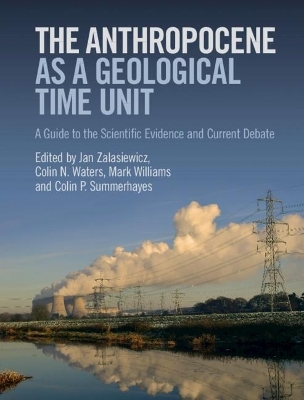
The Anthropocene as a Geological Time Unit
Cambridge University Press (Verlag)
978-1-108-47523-5 (ISBN)
The Anthropocene, a term launched into public debate by Nobel Prize winner Paul Crutzen, has been used informally to describe the time period during which human actions have had a drastic effect on the Earth and its ecosystems. This book presents evidence for defining the Anthropocene as a geological epoch, written by the high-profile international team analysing its potential addition to the geological time scale. The evidence ranges from chemical signals arising from pollution, to landscape changes associated with urbanisation, and biological changes associated with species invasion and extinctions. Global environmental change is placed within the context of planetary processes and deep geological time, allowing the reader to appreciate the scale of human-driven change and compare the global transition taking place today with major transitions in Earth history. This is an authoritative review of the Anthropocene for graduate students and academic researchers across scientific, social science and humanities disciplines.
Jan Zalasiewicz is a Professor of Paleobiology at the University of Leicester and Chair of the Anthropocene Working Group. His research interests include mudrock processes; early Palaeozoic and Quaternary stratigraphy and sedimentology; and stratigraphic analysis, notably the study of the Anthropocene concept. Colin N. Waters is an Honorary Professor in the Department of Geology at the University of Leicester, and secretary of the Anthropocene Working Group with a central role in coordinating activities of the Working Group members. He recently retired as a Principal Mapping Geologist at the British Geological Survey, where he specialised in geological mapping of the UK and parts of the Sahara Desert, and stratigraphical analysis, principally of the Carboniferous and Anthropocene. Mark Williams is a Professor of Palaeobiology at the University of Leicester. He is interested in the evolution of the biosphere over geological timescales, with an emphasis on understanding the rate and degree of current biological change. He was the first secretary of the Anthropocene Working Group from 2009 to 2011. Colin Summerhayes is an Emeritus Associate of the Scott Polar Research Institute at the University of Cambridge. He is a marine geologist and oceanographer with expertise in the role of climate in forming marine sediments, and in interpreting the history of climate from sedimentary records. He is a former Manager of the Stratigraphy Branch of the Exploration Division of BP Research, and former Director of the Institute of Oceanographic Sciences Deacon Laboratory, Wormley.
1. History and development of the Anthropocene as a stratigraphical concept Jan Zalasiewicz, Colin Waters, Mark Williams, Colin Summerhayes, Martin Head, Reinhold Leinfelder, Jacques Grinevald, John McNeill, Naomi Oreskes, Will Steffen, Scott Wing, Phil Gibbard, Davor Vidas, Trevor Hancock and Anthony Barnosky; 2. Stratigraphic signatures of the Anthropocene Bob Hazen, Jan Zalasiewicz, Colin Waters, Andy Smith, Neil Rose, Agnieszka Gałuszka, An Zhisheng, Simon Price, Daniel deB. Richter, Sharon A Billings, James Syvitski and Colin Summerhayes; 3. The biostratigraphical signature of the Anthropocene Mark Williams, Anthony Barnosky, Jan Zalasiewicz, Martin Head, Ian Wilkinson, David Aldridge, Colin Waters, Valentin Bault and Reinhold Leinfelder; 4. The tectonosphere and its physical stratigraphical record Peter Haff, Jan Zalasiewicz, Colin Waters, Mark Williams, Anthony Barnosky, Reinhold Leinfelder and Juliana Ivar do Sul; 5. Anthropocene chemostratigraphy Ian Fairchild, Jan Zalasiewicz, Colin Summerhayes, Colin Waters, Reinhold Leinfelder, Agnieszka Gałuszka, Michael Wagreich, Neil Rose, Irka Hajdas and Catherine Jeandel; 6. Climate change and the Anthropocene Colin Summerhayes and Alejandro Cearreta; 7. The stratigraphical boundary of the Anthropocene Jan Zalasiewicz, Colin Waters, Mark Williams, Colin Summerhayes, Eric Odada, Michael Wagreich, Erich Draganits, Matt Edgeworth, J. R. McNeill, Will Steffen and Martin Head; References; Index.
| Erscheinungsdatum | 02.03.2019 |
|---|---|
| Zusatzinfo | Worked examples or Exercises; 135 Halftones, black and white |
| Verlagsort | Cambridge |
| Sprache | englisch |
| Maße | 193 x 253 mm |
| Gewicht | 990 g |
| Themenwelt | Naturwissenschaften ► Biologie ► Ökologie / Naturschutz |
| Naturwissenschaften ► Geowissenschaften ► Geologie | |
| Technik ► Umwelttechnik / Biotechnologie | |
| ISBN-10 | 1-108-47523-X / 110847523X |
| ISBN-13 | 978-1-108-47523-5 / 9781108475235 |
| Zustand | Neuware |
| Haben Sie eine Frage zum Produkt? |
aus dem Bereich


